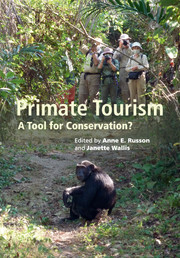Book contents
- Frontmatter
- Contents
- List of contributors
- Part I Introduction
- Part II Asian primates
- Part III African primates
- 7 Lemurs and tourism in Ranomafana National Park, Madagascar
- 8 Some pathogenic consequences of tourism for nonhuman primates
- 9 Baboon ecotourism in the larger context
- 10 Mountain gorilla tourism as a conservation tool
- 11 Evaluating the effectiveness of chimpanzee tourism
- Part IV Neotropical primates
- Part V Broader issues
- Part VI Conclusion
- Index
- References
7 - Lemurs and tourism in Ranomafana National Park, Madagascar
Economic boom and other consequences
from Part III - African primates
Published online by Cambridge University Press: 05 September 2014
- Frontmatter
- Contents
- List of contributors
- Part I Introduction
- Part II Asian primates
- Part III African primates
- 7 Lemurs and tourism in Ranomafana National Park, Madagascar
- 8 Some pathogenic consequences of tourism for nonhuman primates
- 9 Baboon ecotourism in the larger context
- 10 Mountain gorilla tourism as a conservation tool
- 11 Evaluating the effectiveness of chimpanzee tourism
- Part IV Neotropical primates
- Part V Broader issues
- Part VI Conclusion
- Index
- References
Summary
Introduction
Because Madagascar has been isolated from other continents for more than 150 million years (Jernvall & Wright, 1998; Kremen et al., 2008), it is characterized today by an extraordinary biodiversity that is unique to the island. Over the past 1000 years, 90% of Madagascar’s natural habitat has been destroyed, likely due primarily to human impact (Green & Sussman, 1990; Perez et al., 2005). Today many of its endemic species of plants and animals are threatened or endangered due to a combination of habitat destruction and hunting (Banks et al., 2007; Mayor et al., 2004; Wright et al., 2008). In very recent years tourism may have become an additional factor affecting Malagasy biodiversity. Madagascar’s diverse ecosystems, including spiny desert, subtropical dry forest, and rainforests, are all now contained in protected areas visited by tourists (Garbutt, 2009; Mittermeier et al., 2010).
Before the national park system was organized, tourism in Madagascar was primarily limited to beach resorts. A 15-year Environmental Action Plan was started in 1990 through which the national protected area system was established and the Association Nationale pour la Gestion des Aires Protégées (ANGAP) was organized to manage it (Wright & Andriamihaja, 2002). In 1990 there were two national parks in Madagascar, but by 2008, 18 had been established (Figure 7.1). Today the majority of ecologically minded tourists visit three of those parks: Mantadia, Isalo, and Ranomafana. In 2008, ANGAP was renamed Madagascar National Parks (MNP).
- Type
- Chapter
- Information
- Primate TourismA Tool for Conservation?, pp. 123 - 146Publisher: Cambridge University PressPrint publication year: 2014
References
- 13
- Cited by

